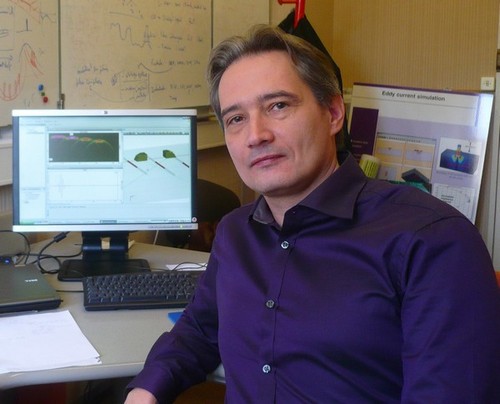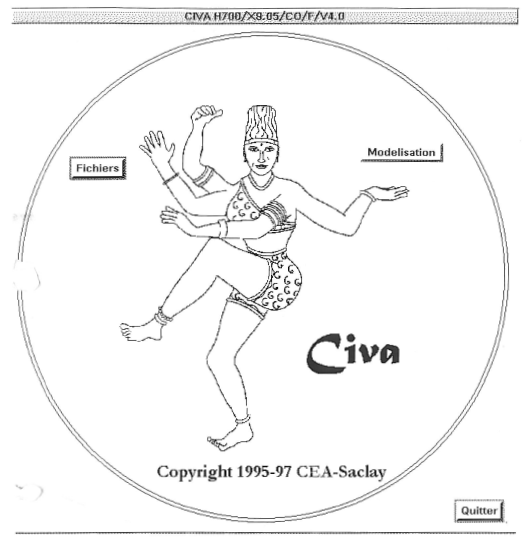Steve Mahaut | CEA
27th September, 2011
Dr. Steve Mahaut, head of the Laboratory of Simulation and Modeling at the CEA, accepted to receive us in his office, to talk about CIVA and his story related to this project.

How was the CIVA project born?
The CIVA project started in 1992, aiming at replacing the SPARTACUS software dedicated to the acquisition and processing of ultrasonic data.
It was launched by M. Philippe Benoist, who was the head of the ultrasonic testing laboratory at the CEA. Compared to SPARTACUS, CIVA had two complementary objectives: beyond analysis and data processing, CIVA would also integrate modeling codes, and would also provide imaging and simulation of other NDT techniques (Eddy Current and radiography in particular). The first presentation of CIVA was held in Nice (France) in 1994.
When did you start working on the CIVA project?
I contributed to some modeling developments in the middle of the 90’s, as part of my PhD thesis. From 1997 to 2002, I was hired as a project manager for studies involving experimental tests, simulation studies and analysis. I was essentially a CIVA user, and specialized in phased-array techniques. I have also been in charge of the initial CIVA training sessions, beginning with version 6, in the early 2000s. As the number of CIVA users increased, due to its availability for PCs, needs for training, support and validation also increased. I was in charge of these tasks, which further led to the creation of the Validation and Tests Laboratory in 2002. In 2006 I was appointed head of the Laboratory of Simulation and Modeling, which dealt with electromagnetic and ultrasonic models developed in CIVA.
This laboratory, along with the Software Development Laboratory, in charge of software engineering (GUIs, imaging, software architecture…), headed by M. Stéphane Leberre, is mostly dedicated to CIVA development. Since 2004, CIVA developments are coordinated by a project manager (initially M. Philippe Dubois, then M. Frédéric Jenson, and now M. Nicolas Dominguez).
How did you get into this project?
I arrived at the CEA as part of my PhD thesis, funded by the IPSN (nuclear safety authorities). I started in 1993 on the contribution of phased-array techniques to NDT. My thesis had a large experimental contribution, but also some developments in modeling of the ultrasonic field radiated by phased-array transducers. I integrated these developments to the software CHAMP-SONS, a field calculation module that became part of CIVA modeling tools.
Were you there at the beginning of the project?
At the beginning of the project, in 1992, the emphasis was put on imaging and multi-technique analysis. Consequently, my very first contributions were to deal with the integration of ultrasonic phased-array modeling in the CIVA 4 version.
How many people and laboratories were there at the beginning of the project?
Several people were involved in the project at various levels, due to the initial desire to integrate different NDT techniques. However, those involved nearly full-time accounted for less than ten people, and focused on imaging and data processing.
The main laboratory involved was the Ultrasonic Laboratory, with other CEA laboratories (electromagnetic methods and radiography).
How and when have the Eddy Current and the radiography modules been integrated?
In terms of imaging, Eddy Current was included in the first version of CIVA. The modeling tools, developed in the Electromagnetic Method Testing Laboratory, have been integrated since the transfer of CIVA to PC in the version 6.1. These codes, developed in Matlab, have been integrated in CIVA and use the common CIVA GUI with its extended features.
As for Eddy Current, imaging and processing tools for radiographic images existed at the very beginning of CIVA. Then a first simulation module, developed by the CEA-LETI (the SINDBAD code) was integrated in version 5. Right now, the RT simulation module is fully integrated with the GUI and imaging features common to the ultrasonic and electromagnetic modules, and takes advantage of two simulation codes: SINDBAD, mentioned above, and MODERATO, developed by EDF.

Did the way of using CIVA change since its early days?
The philosophy of CIVA has remained the same since the beginning: to provide simulation and analysis tools for NDT experts, while maintaining a user friendly GUI rather than one oriented toward technical experts in modeling and analysis. We wanted the imaging tools to respect NDT practices, and to provide additional tools such as comparisons of experimental and simulated images, as well as images displayed and represented in the specimen coordinate system (corrected UT, ECT or RT cartographies superposed to the parts…). However, the main contributions and innovative features of CIVA over the 90’s were the developments of NDT models.
Did the fields of application evolve?
From the beginning, the modeling tools were based on semi-analytical models to provide fast computation times (compatible with intensive industrial use), while requiring little numerical expertise from users. These models had a very limited scope: the first application cases related to isotropic, homogeneous and canonical (planar and cylindrical) specimen.
In terms of ultrasonic testing, for example, the initial configurations were limited to immersed focused transducers. Over the years, models have been extended to take into account more and more complex probes, specimens, flaws, and inspection procedures. This allowed us to answer problems from various industries.
When did aeronautics started to be taken into account in the developments, and how?
Aeronautics has quickly been one of the main sectors that required modeling tools. It was also one of the first major partners outside of the nuclear industry. Applications linked in particular to the control of composites and complex parts have led to different models, which helped to provide new features on CIVA, ultrasonic and Eddy Current modeling in particular. Today, aeronautics is widely active in the field of PODs and remains a major partner in the development of CIVA.
What were the biggest challenges in modeling?
Without going into details, semi-analytical methods (mostly integral formulations) have always been the heart of the developments undertaken at the CEA. The difficulty is to determine precisely the limits of such models, whether they are implementation of classic literature or new formulations developed at the CEA. Since we seek to develop generic models, which can deal with an increasing number of configurations, a validation work has to be conducted to ensure satisfactory results regardless of the settings defined by the user. This validation is carried out through experimental tests at CEA, but also through regular participations in benchmarks, including the benchmark proposed by the WFNDEC and presented at the QNDE conference every year since 2004.
Is it a blocking point to make a model based only on semi-analytical calculations?
Semi-analytical models have two advantages: in addition to their performances regarding calculation time and numerical cost, they allow a detailed understanding of simulation results, because they are based on the model of a particular phenomenon (we know what we are modeling, and from there, we can optimize a technique for this kind of control). In many configurations that require simulation, a NDT expert is often able to roughly define the method he will apply to detect and / or characterize any given default. The simulation and the optimization of this method can be treated completely or partially by the interaction models in CIVA. For instance, ultrasound and radiography simulation codes now allow to handle CAO3D specimens, and rather complicated flaws. Eddy Currents models are more limited in terms of geometry (plane or cylindrical), but in return, given the small size of the sensors compare to the characteristic size and curvature of the specimens, approximations often apply.
However, for particularly complex configurations (geometry and materials), semi-analytical methods cannot answer all the problems. For these configurations it may be necessary to use numerical methods. These methods, like finite elements, remain a subject of study for many laboratories. They accurately solve elastodynamic and electromagnetic states, but are very demanding for 3D applications in terms of calculation time and memory load. In this area, numerical methods are continuously improving, thanks to high order methods, PML-type methods.
Furthermore, progress in terms of hardware architecture (multi-processor, GPU cards) also leads to improved performances by using parallelization, which is also good for semi-analytical methods. However, all numerical methods are based on a spatial meshing of the configuration, which can be difficult depending on the topology of the configuration.
CIVA models are essentially semi-analytical, but hybrid models that combine semi-analytical and numerical methods (CIVA coupled with the ATHENA finite-element code developed by EDF to simulate UT techniques, for example) have also been developed. CIVA calculates an incident field at the boundary of a small finite-element box. This incident field is therefore used as an initial source, which then propagates and interacts with flaws inside the FE box. Finally, the outputs of the FE box are coupled with the field of the receiving probe to predict the final echographic response.
These modeling approaches are a major collaboration axis between the CEA and various partners, particularly in the CARNOT CIVAMONT project, associating the CEA and various French and European academic laboratories since 2007.
